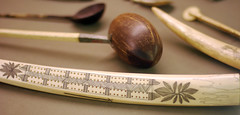I've been realizing this blog is drifting towards aiming squarely at history of medicine types, so I'm going to try to wrench it in a slightly different direction. Here's how I spent part of my day as an archivist today.
I was walking through the exhibit floor this morning and heard voices coming out of our
Human Body, Human Being exhibit. The exhibit flooded over the weekend when Washington got 5-7 inches of rain. That side of the museum is built into a hill and has been flooding off and on for about a decade now. On the past Monday, the exhibits and collection staff had dismantled the exhibits against the wall - on the urinary system and bones - and moved them out of the way so the building engineers could look up and say, "yup, it's leaking water."
The whole hall (the Anatifacts area in this map), which is about 1/4 of the exhibit floor, was closed all week, but this morning Steve Hill, head of our exhibits staff, Tim Clarke Jr, our public relations guy and Beth Eubanks, our registrar, were muscling some of the exhibit cases into a new configuration about 10 feet from the wall. I lent a hand and helped and a little after opening the cases were in place. Brian Spatola, collections manager of anatomical collections, brought the specimens back from storage and the four of them put the display back together. Meanwhile...
...I was leading a tour of people who had bought a silent auction benefit behind-the-scenes tour. Our former PR guy Steven Solomon had started these a few years back. We started in historical collections where collections manager Alan Hawk pulled out a bunch of surgical kits dating from the Civil War until World War II, and then showed them wax and plaster models of facial reconstruction surgery from the same time period. Anatomical curator Franklin Damann was giving a tour of his own in anatomical collections, so we swapped groups and he showed my group Civil War amputated femurs, Ham the space chimp, plastinated organs and a quick glance into the wet tissue room where specimens are stored in bottles of formalin.
We combined the two groups and neuroanatomical collections manager Archie Fobbs displayed some of our brain slides. Instead of making a microscope slide, his predecessors sectioned and mounted slices of whole brains and you can see stroke or tumor damage. I think the high point for the group was when Archie opened up his demo tub of a brain preserved in alcohol and let people handle it. Nobody was in the Human Developmental Anatomy Center, so I did a quick riff on scanning slides of embryos which had been collected 100 years ago to make first wax or plaster models of organ systems. These are now being scanned with the models made in the computer. Finally I gave my standard tour of the archives, including a letter signed by Walter Reed, a 1917 doctor's diary, a revised confidential asbestosis report for Johns Manville from 1949, a lantern slide photograph of a survivor from Hiroshima, an album of the museum's Civil War Surgical Photographs and some of our trade lit advertising material.
So there's a good bit of a typical day. If there's interest in more posts like this, comment below please.


